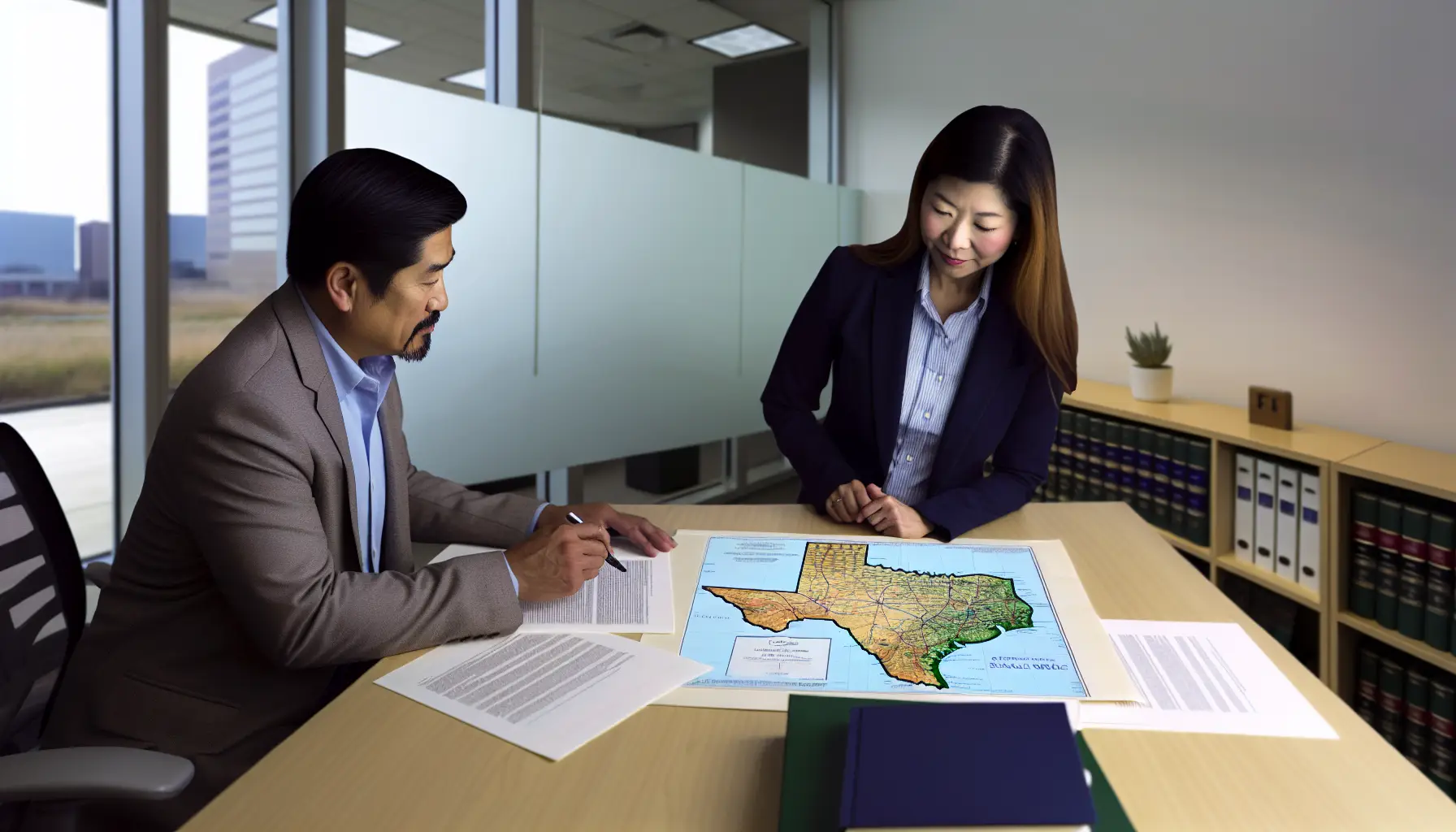Learn how Texas vested rights protect developers from regulatory changes. Discover the power of ‘fair notice,’ exemptions to be aware of, and how an attorney can help secure your project’s future.
For Texas real property developers, the journey from the blueprint to the building is paved with a complex web of regulations and permits required. But in this landscape of evolving rules, one legal concept stands as a beacon of stability: Texas vested rights. These rights, commonly referred to as vested rights, ensure that once a development project gets rolling, it generally proceeds under the rules that were in place at the time of its inception.
A vested rights determination is critical in the Lone Star state. We’re going to uncover the intricacies of this powerful legal tool. We’ll look at why a keen understanding of the Texas Vested Rights Statute is beneficial for anyone involved in Texas real estate development.
In This Article:
Understanding Texas Vested Rights
Chapter 245 of the Texas Local Government Code, often referred to as the “Vested Rights Statute,” forms the backbone of vested rights in Texas. It outlines when these rights are triggered and defines their scope. In essence, once a developer files a permit application that provides “fair notice” of the project, subsequent changes to ordinances, regulations, or rules can’t derail it.
Imagine this scenario: you’ve just submitted a comprehensive permit application to erect a mixed-use building in Houston, aligning perfectly with the current zoning regulations. Weeks later, the city enacts new zoning rules, significantly limiting the allowable lot coverage and building size for buildings in that area. Thanks to Texas vested rights, your project remains governed by the zoning regulations in effect on the date of your initial application, sometimes called the original application.
The Power of “Fair Notice”
That said, “fair notice” is not a vague concept in the eyes of the law. According to Section 245.002(a-1), this critical element mandates that the permit application must clearly define the project’s scope and the permits required.
A vague application simply won’t cut it. Let’s say your initial application lacks detailed preliminary plans for wastewater disposal, only to have local regulations regarding wastewater treatment change after your application date. In such a case, arguing that your vested rights protect you from these new regulations may not hold water (no pun intended.). Why? Your application didn’t provide fair notice of your proposed approach to wastewater, a vital aspect of your project.
Key Components of Texas Vested Rights
Several key components underpin the effectiveness of Texas vested rights:
- Timely Permit Application: File your initial application early. Doing so locks in the existing regulations and forms the cornerstone of vested rights. This seemingly simple step can shield your project from later changes to building codes, zoning ordinances, or permitting fees.
- Comprehensive Application: Include everything necessary in that initial application. Vague or incomplete applications invite disputes. For larger, multi-phased developments, submitting a detailed master plan can prevent future conflicts over what is considered part of the initially vested project.
- Diligent Project Pursuit: Vested rights are a protection, not a free pass. While the law provides some leeway for delays, abandoning your project for an extended period could result in losing those vested rights. Regularly check in on your permits to ensure they haven’t expired or don’t require updates to stay current.
The Importance of Legal Counsel
While this article can offer some helpful explanations about Texas vested rights relating to real property law, working with an attorney can make all the difference. Attorneys specializing in land development understand the complexities of vested rights and can navigate the legal terrain strategically. Their expertise is invaluable in handling challenges that may arise, particularly if your project triggers local regulatory changes or faces opposition from community groups.
Remember, while vested rights provide a degree of certainty in a world of shifting regulations, they aren’t foolproof. Texas vested rights protect a project from changes in local rules and ordinances. This is not a protection against violations of state or federal laws. Those will still be enforceable regardless of when your project began.
Navigating Challenges to Texas Vested Rights
While the Texas Vested Rights Statute offers a vital safety net for developers, situations do arise where vested rights are disputed or their application is less than crystal clear. Let’s look at common challenges that could surface.
Exemptions to Texas Vested Rights
Chapter 245, while seemingly comprehensive, isn’t absolute in its scope. Recognizing the need for a balance between economic development and public interest, the statute does carve out specific exemptions where Texas vested rights may not apply. Understanding this is important before proceeding with development.
Regulations deemed essential for public safety, such as those implemented to address immediate dangers to property or life, fall under these exceptions. A common example? Emergency ordinances enacted after a natural disaster, like a hurricane or a major fire, which might override vested rights to facilitate a faster, more streamlined recovery. Developers should always stay abreast of these kinds of developments as well.
Changes in Project Scope
Modifying your project mid-stream can have significant implications. Any changes introduced after the initial permit filing might not fall under the protective umbrella of your already secured vested rights. For instance, imagine that your initial proposal was for a 10-story apartment building in Austin, and you have secured vested rights based on the zoning regulations at that time. Later, you decide to increase the building height to 15 stories.
Those additional five floors, being a substantial modification of the project’s original scope, might not be protected by the previously secured vested rights, especially if newer, more stringent zoning regulations are now in place. In these situations, consulting with a knowledgeable real estate attorney in Texas is critical to assessing potential risks and exploring possible workarounds. Navigating such complexities underscores why early, comprehensive planning, and accurate, detailed permit applications are crucial. This is true even in the very beginning phases of a project when dealing with Texas vested rights.
Statute of Limitations Disputes
While not directly related to vested rights, the statute of limitations, specifically as it relates to construction defect claims, can intertwine with the concept of vested rights, creating unexpected complexities for developers. For example, let’s say you complete a development project in Dallas that, during its initial planning and permit application phases, fell under a 10-year statute of limitations for construction defects.
Several years later, the Texas Legislature amends this statute, shortening it to 5 years. Now, a question arises:
Which statute of limitations applies to your project—the 10-year timeframe under which you secured vested rights or the newer 5-year timeframe?
Resolving such conflicts often hinges on legal interpretations of whether the vested rights attached to the project at the time of permit approval also encompass the statute of limitations that was valid then.
The legal landscape surrounding Texas vested rights continues to evolve, making it crucial for developers and industry professionals to remain informed. Staying updated through reputable sources like the Municode Library and consulting with attorneys experienced in this dynamic area can prove invaluable. The intersection of statutes, court decisions, and changing regulations emphasizes the significance of specialized knowledge when dealing with vested rights in real estate development.
Conclusion
Texas vested rights are a crucial principle in the Lone Star state. They provide a level of predictability for those embarking on real estate projects. They are the embodiment of fairness, ensuring that those who play by the rules during the initial phases of development are not penalized by subsequent changes in regulations.
Resources:
For comprehensive information on Texas vested rights, refer to Chapter 245 of the Texas Local Government Code, which outlines the issuance of local permits and the protections afforded to developers against regulatory changes.
Texas Statutes





















